

Brain Rules: 12 Things We Know About How The Brain Works. Dr. Shanker and Self Regulation – Continuing the Conversation. February 19, 2013 by cultureofyes Two of my most popular posts have been about Dr.
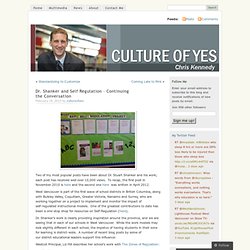
Stuart Shanker and his work; each post has received well over 10,000 views. To recap, the first post in November 2010 is here and the second one here was written in April 2012. West Vancouver is part of the first wave of school districts in British Columbia, along with Bulkley Valley, Coquitlam, Greater Victoria, Nanaimo and Surrey, who are working together on a project to implement and monitor the impact of self-regulated instructional models.
One of the greatest contributions to date has been a one-stop shop for resources on Self-Regulation (here). Dr. Westcot Principal, Liz Hill describes her school’s work with The Zones of Regulation: We often make the assumption that children know how to identify their emotions, but akin to teaching reading, writing and math, emotional literacy is a skill that needs to be taught to our children. Like this: Mindful Teaching and Teaching Mindfulness - Educate My Mind... Ten Signs Your Child Might Have An Anxiety Disorder. As part of our series on National Children’s Mental Health Awareness Week (May 6-12) we’ve been posting interviews and information about children and mental health.
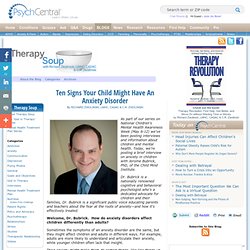
Today, we’re posting a brief interview on anxiety in children with Jerome Bubrick, PhD, of the Child Mind Institute. Dr. Bubrick is a nationally renowned cognitive and behavioral psychologist who’s a dedicated advocate for children and their families, Dr. Bubrick is a significant public voice educating parents and teachers about the fear at the roots of anxiety—and how it’s effectively treated. 12 Things You Should Be Able to Say About Yourself.
You only live once, but if you do it right, once is enough. – Mae West You know you’re on the right track when you can repeat each of the following headlines to yourself, honestly.
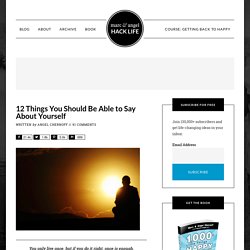
(And if you can’t, this list gives you something positive to work on.) The Importance of Teaching Mindfulness. Flickr: ssoosay By Aran Levasseur Think of sitting quietly in a spartan room. There are no TVs, computers, smartphones, books, magazines or music. If you’re like most people, this probably sounds like a recipe for boredom.
In our culture, we avoid moments of “not-doing” because we don’t associate boredom with having any value. It’s been said that the currency of the Net is attention. Anxiety: It's Not What You Have, It's What You Do. “If we don’t recognize what is going on in our heads we find it easy to assume that somehow our anxieties come to us ready made from the outside.
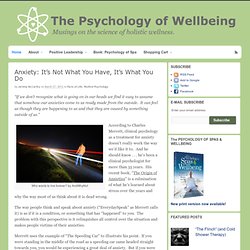
It can feel as though they are happening to us and that they are caused by something outside of us.” Who wants to live forever? Autism, Aspergers, ADHD. A Mindfulness Curriculum for Adolescents. How To Teach The Relaxation Response. Tips for Teaching Mindfulness to Kids. How can we build the quality of mindfulness in our children, our classrooms, and our schools?
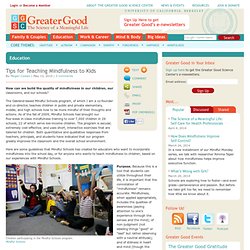
The Oakland-based Mindful Schools program, of which I am a co-founder and co-director, teaches children in public and private elementary, middle, and high schools how to be more mindful of their thoughts and actions. As of the fall of 2009, Mindful Schools had brought our five-week in-class mindfulness training to over 7,000 children in 26 schools, 22 of which serve low-income children. The program is secular, extremely cost-effective, and uses short, interactive exercises that are tailored for children. Both quantitative and qualitative responses from teachers, principals, and students have indicated that our program greatly improves the classroom and the overall school environment. Purpose. Teachers Guide. By Dr.

Amy Saltzman Download this guide as a .pdf or a Word .doc. Center for Wellness and Achievement in Education. How To Start a Meditation Program in Your School. Middle school teacher Rose Ludwig rings the bell to begin Quiet Time, a daily program of silence and optional meditation for students.
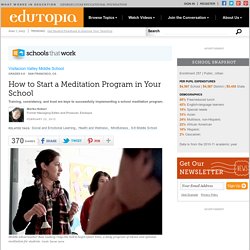
Quiet Time (QT) is a program of mandatory quietude and optional meditation that happens schoolwide, twice a day at Visitacion Valley Middle School (VVMS) in San Francisco. It was implemented by the Center for Wellness and Achievement in Education (CWAE), a San Francisco nonprofit organization that is a national leader of whole-school implementation of QT. Here are some of the pieces that needed to come into place for QT to run and succeed at VVMS as well as tips for how you can get started and trained. Setup and Process To ensure success, the setup is critical. A good duration for QT in middle school is 15 minutes. The first bell at the beginning of minute zero signals the start of QT.
Requirements for Success. Classroom Mindfulness. Mindful Schools - Engaging children. Supporting educators. Transforming schools. Positive Psychology Interventions with Depression. Sometime in the last century I was stuck in the Geneva airport waiting for a snowstorm to pass so that I could catch my long-delayed flight home.
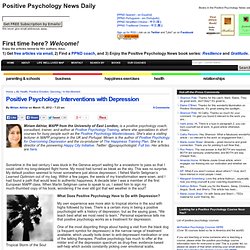
My mood had turned as bleak as the sky. This was no surprise. My default position seemed to hover somewhere just above depression. I fished Martin Seligman’s Learned Optimism out of my bag. Within a few pages, the seeds of my transformation were sown, and I had found a path that would lead to authentic happiness. What Does Positive Psychology Have to Do with Depression? My own experience was more akin to tropical storms in the soul with highs followed by lows.